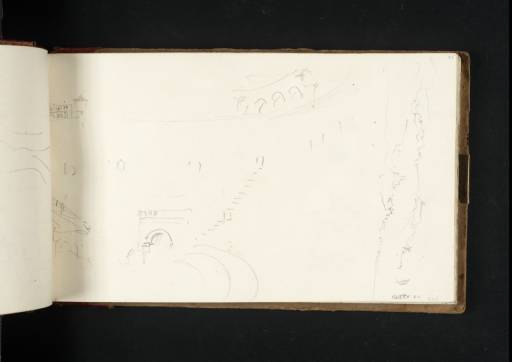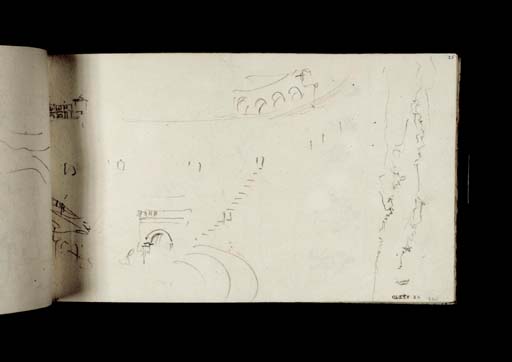Joseph Mallord William Turner The Arena of the Amphitheatre at Verona; Buildings among Hills 1819
Image 1 of 2
Joseph Mallord William Turner,
The Arena of the Amphitheatre at Verona; Buildings among Hills
1819
Joseph Mallord William Turner 1775–1851
Folio 25 Recto:
The Arena of the Amphitheatre at Verona; Buildings among Hills 1819
D14363
Turner Bequest CLXXV 25
Turner Bequest CLXXV 25
Pencil on white wove paper, 112 x 185 mm
Inscribed by John Ruskin in blue ink ‘25’ top right and ‘300’ bottom right
Stamped in black ‘CLXXV 25’ bottom right
Inscribed by John Ruskin in blue ink ‘25’ top right and ‘300’ bottom right
Stamped in black ‘CLXXV 25’ bottom right
Accepted by the nation as part of the Turner Bequest 1856
References
1909
A.J. Finberg, A Complete Inventory of the Drawings of the Turner Bequest, London 1909, vol.I, p.512, CLXXV 25, as ‘An amphitheatre (?) (?at Verona)’.
1990
Eric Shanes, Turner’s Human Landscape, London 1990, pp.34, 350 note 46.
With judicious crossings-out, the Turner scholar C.F. Bell amended Finberg’s somewhat tentative 1909 Inventory entry to read: ‘Amphitheatre at Verona’.1 Turner’s view is from within the Roman arena, looking north-west to the arched entrance at that end and north to the four last surviving arches of the ‘ala’ or wing on the outer perimeter beyond the tiered seating. The generally well-preserved building is now a venue for operas and concerts.
Another view at the outer edge, made with the page turned vertically, is a slight study of buildings among low hills, probably made somewhere in the vicinity.
There are further sketches of the amphitheatre and other Verona sites on folios 24 recto, 26 recto–29 verso and 31 recto (D14361, D14364–D14370, D14372). For the city in relation to Turner’s route east across northern Italy to Venice, see the sketchbook’s Introduction. In 1833 the artist passed through again, making numerous studies in the Vienna up to Venice (formerly ‘Lintz, Salzburg, Innsbruck, Verona and Venice’) sketchbook (Tate D31531–D31532, D31538–D31541, D31547–D31549, D31551–D31559, D31561–D31563, D31577–D31579; Turner Bequest CCCXI 58a–59, 62a–64, 67–68, 69–75, 83–84).
Another sketchbook Turner carried with him on this tour includes travel notes by James Hakewill (1778–1843), with whom he had been collaborating on the Picturesque Tour of Italy (published in 1820); see Nicola Moorby’s Introduction to the Route to Rome book (Tate; Turner Bequest CLXXI). Hakewill mentioned: ‘Verona – | Amphitheater | Gates – | View from Count Guisti’s | Tomb of Romeo & Juliet’ (Tate D13899; Turner Bequest CLXXI 22). Going by its apparent subject relating to Shakespeare’s Verona-set Romeo and Juliet, Turner’s oil painting Juliet and her Nurse, exhibited in 1836 (private collection)2 might have been expected to show the city; in fact, its setting is unmistakably Venice, as acknowledged in the title of the 1842 engraving taken from it (Tate impression: T05188).3
Verso:
Blank
Matthew Imms
March 2017
How to cite
Matthew Imms, ‘The Arena of the Amphitheatre at Verona; Buildings among Hills 1819 by Joseph Mallord William Turner’, catalogue entry, March 2017, in David Blayney Brown (ed.), J.M.W. Turner: Sketchbooks, Drawings and Watercolours, Tate Research Publication, July 2017, https://www


